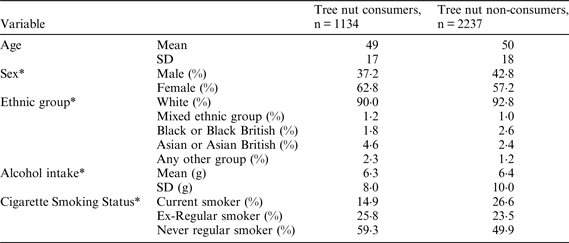Nutritional compositions of tree nuts, including almonds, walnuts and pistachios, have been shown to have beneficial effects on cardiovascular health( Reference Berryman, Preston and Karmally 1 , Reference Ros 2 ). Evidence from the National Health and Nutrition Examination Survey (NHANES) suggests that tree nut consumers make up a small proportion of the US population (6·8 %), but that consumption was associated with reductions in risk factors associated with metabolic syndrome( Reference Papanikolaou, O'Neil and Nicklas 3 , Reference O'Neil, Fulgoni and Nicklas 4 ). The aim of this research was to investigate associations between tree nut consumption and cardiovascular disease (CVD) risk markers in UK adults.
Cross sectional analysis was carried out using data from the UK National Diet and Nutrition Survey (NDNS) rolling programme (2008–2014)( 5 ) including data from 3,371 individuals aged ≥19 y who completed a 4-d estimated food diary. Available data on CVD risk markers included BMI (kg/m2), waist circumference (WC; cm), fasting blood lipids (triacylglycerols (TAG), LDL- and HDL-cholesterol; mmol/l), systolic and diastolic blood pressure (SBP and DBP; mmHg) and C-reactive protein (CRP; mg/l). Using multivariate linear regression models, individual components of tree nut consumption were related to CVD risk markers, adjusting for covariates such as age, sex, ethnicity, socio-economic status, smoking status, alcohol intake and energy intake. Tree nut consumption was defined as: 1) nut snacks only, 2) total consumption including composite dishes. The table shows characteristics of tree nut consumers including composite dishes compared to non-consumers.

Mann-Whitney U test was performed for age and alcohol intake (energy adjusted). For sex, ethnic group and cigarette smoking status, chi-square test was used. *p < 0·001, indicating a significant difference.
Tree nut consumption including composite dishes significantly predicted all CVD risk markers (p < 0·001) and was associated with 0·008 mmHg lower SBP (p = 0·010) for every gram increase in consumption per 1000 kcal of total energy intake. Tree nut snack consumption significantly predicted all CVD risk markers except for LDL-cholesterol, but changes in these markers for every gram increase in consumption per 1000 kcal of total energy intake were not statistically significant. Tree nut consumption significantly predicted CVD risk with most of the factors, and tree nut consumption including composite dishes was associated with lower SBP. The importance of including tree nuts in an overall healthy diet should be emphasized to help reduce CVD risk.


